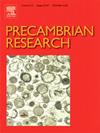The role of environmental pressures on stromatolite morphology: Insights from the Ediacaran Salitre Formation, Irecê Basin, Brazil
IF 3.2
2区 地球科学
Q2 GEOSCIENCES, MULTIDISCIPLINARY
引用次数: 0
Abstract
Stromatolites are laminated biosedimentary structures that record long-standing interaction between environmental conditions and coevolving microbial life. Although they are among the oldest and most persistent forms of life on Earth, the extent to which environmental parameters affect their morphology and distribution remains poorly understood. In this study, we investigated the well-exposed stromatolites of the Ediacaran Salitre Formation (Irecê Basin, Brazil) to assess how physical sedimentary processes and early lithification dynamics controlled stromatolite growth and form. Through integrated sedimentological and petrographic analyses, we documented a stratigraphic transition from stratiform to columnar morphologies, which closely correlates with variations in hydrodynamic energy, sediment influx, and local relief. Our results demonstrate that increased hydrodynamic energy and detrital input promoted the development of columnar, often inclined or branched forms, whereas low-energy conditions allowed for the development of stratiform structures, especially within protected scour depressions. The occurrence of inclined, yet unbroken stromatolite columns and their alignment with the paleoflow indicators suggest growth under dynamic, high-energy conditions with weak or incomplete synsedimentary lithification. Despite the high-energy setting, grains are concentrated only within the intercolumnar spaces and are almost absent from the stromatolite laminae, suggesting that lamination resulted primarily from microbial carbonate precipitation rather than sediment trapping. Additionally, the internal lamination patterns and detrital material distribution reflect episodic sedimentation and microbial mat disruption, further emphasizing the sensitivity of stromatolite morphology to environmental changes. Our findings highlight that the stromatolites in the Salitre Formation provide a valuable snapshot of the intricate interplay between physical parameters and biological activity during the terminal Neoproterozoic.
环境压力对叠层石形态的影响:来自巴西Irecê盆地埃迪卡拉纪盐层组的启示
叠层石是层状生物沉积结构,记录了环境条件和共同进化的微生物生命之间长期的相互作用。虽然它们是地球上最古老和最持久的生命形式之一,但环境参数对其形态和分布的影响程度仍然知之甚少。本研究以巴西Irecê盆地埃迪卡拉系盐层组的叠层石为研究对象,探讨了物理沉积过程和早期岩化动力学如何控制叠层石的生长和形成。通过综合沉积学和岩石学分析,我们记录了地层形态从层状到柱状的转变,这与水动力能、沉积物流入和局部起伏的变化密切相关。我们的研究结果表明,增加的水动力能量和碎屑输入促进了柱状结构的发展,通常是倾斜或分支形式,而低能量条件允许层状结构的发展,特别是在受保护的冲刷洼地内。斜而完整的叠层石柱的出现及其与古流动指示物的排列表明,叠层石是在动态、高能条件下生长的,同沉积岩化作用弱或不完全。尽管处于高能量环境,但颗粒只集中在柱间空间内,叠层石层叠层中几乎没有颗粒,这表明层叠主要是由微生物碳酸盐沉淀而不是沉积物捕获造成的。此外,叠层石内部的层压模式和碎屑物质分布反映了幕式沉积和微生物席破坏,进一步强调了叠层石形态对环境变化的敏感性。我们的研究结果强调,盐层组的叠层石为新元古代末期物理参数与生物活动之间复杂的相互作用提供了有价值的快照。
本文章由计算机程序翻译,如有差异,请以英文原文为准。
求助全文
约1分钟内获得全文
求助全文
来源期刊

Precambrian Research
地学-地球科学综合
CiteScore
7.20
自引率
28.90%
发文量
325
审稿时长
12 months
期刊介绍:
Precambrian Research publishes studies on all aspects of the early stages of the composition, structure and evolution of the Earth and its planetary neighbours. With a focus on process-oriented and comparative studies, it covers, but is not restricted to, subjects such as:
(1) Chemical, biological, biochemical and cosmochemical evolution; the origin of life; the evolution of the oceans and atmosphere; the early fossil record; palaeobiology;
(2) Geochronology and isotope and elemental geochemistry;
(3) Precambrian mineral deposits;
(4) Geophysical aspects of the early Earth and Precambrian terrains;
(5) Nature, formation and evolution of the Precambrian lithosphere and mantle including magmatic, depositional, metamorphic and tectonic processes.
In addition, the editors particularly welcome integrated process-oriented studies that involve a combination of the above fields and comparative studies that demonstrate the effect of Precambrian evolution on Phanerozoic earth system processes.
Regional and localised studies of Precambrian phenomena are considered appropriate only when the detail and quality allow illustration of a wider process, or when significant gaps in basic knowledge of a particular area can be filled.
 求助内容:
求助内容: 应助结果提醒方式:
应助结果提醒方式:


